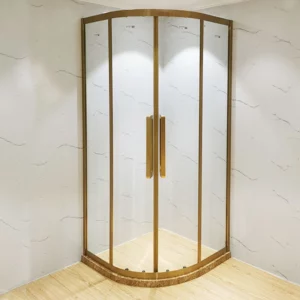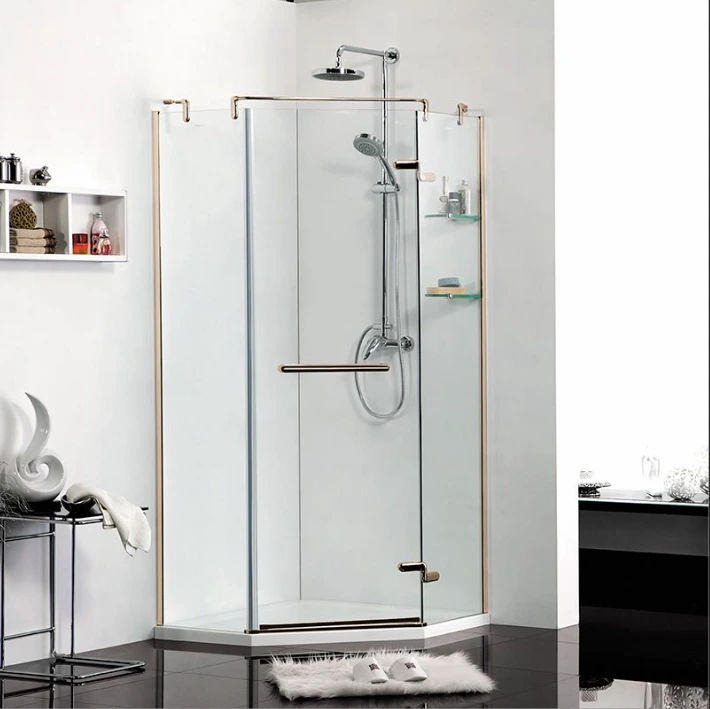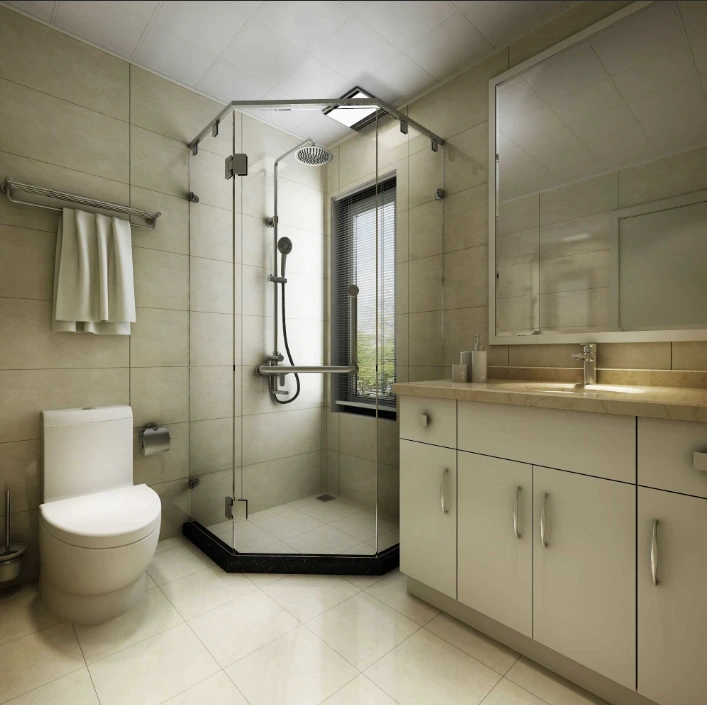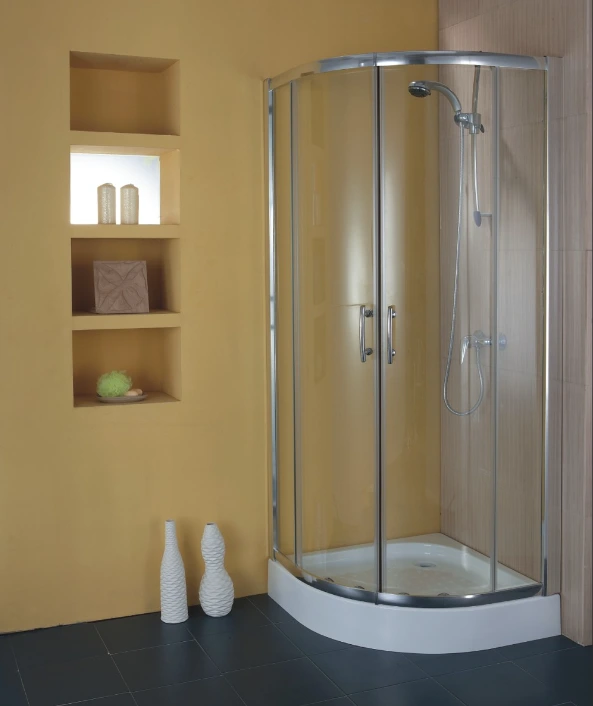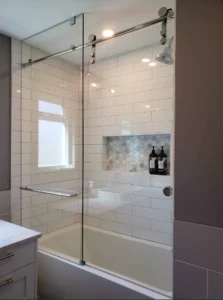How to Measure a Single Door Quadrant shower enclosure?
When installing a single door quadrant shower enclosure, it is important to accurately measure the space in your bathroom where the enclosure will be installed. A correct measurement will ensure that the enclosure fits properly and functions as it should. Here are the steps to take to measure your shower space:
Measure the width of the space. Measure from wall to wall at the widest point of the shower opening. This measurement will give you the width of the shower enclosure you need to purchase.
Measure the height of the space. Measure from the floor to the top of the shower opening. This measurement will give you the height of the shower enclosure you need to purchase.
Determine the location of any obstructions. Check for any pipes, electrical outlets, or other obstructions in the shower area that might impact the placement of the shower enclosure. Make note of these obstructions and their location.
Measure the depth of the space. Measure from the back wall to the front of the shower opening. This measurement will give you the depth of the shower enclosure you need to purchase.
Measure the radius of any curves or angles in the space. If your shower space has curves or angles, you will need to measure the radius of these shapes to ensure that the shower enclosure fits properly.
It is important to take accurate measurements, as shower enclosures are usually made to order and cannot be returned once they have been manufactured. Take the time to measure your shower space carefully and double check your measurements before you place your order. If you have any doubts or questions about measuring your shower space, consult with a professional or the manufacturer of the shower enclosure you are considering.
How to Measure a square shower enclosure?
Measuring for a square shower enclosure is an important step in the process of installing a new shower unit. There are several factors to consider when taking measurements for a square shower enclosure, including the size of the shower base or bathtub, the height of the enclosure walls, and the location of plumbing fixtures such as showerheads and faucets.
Here is a step-by-step guide to measuring for a square shower enclosure:
Measure the size of the shower base or bathtub. This will give you the length and width of the enclosure that you need to purchase. Make sure to measure from the outermost points of the base to ensure an accurate measurement.
Measure the height of the shower walls. The height of the shower enclosure walls will affect the size of the enclosure that you need to purchase. Standard shower enclosures are usually 72-75 inches tall, but you can choose a different height if desired.
Consider the location of plumbing fixtures. If you have a showerhead or faucet that is located at a different height than the standard height of the shower walls, you will need to take this into account when measuring for your enclosure.
Measure the space available for the enclosure. Before purchasing a square shower enclosure, it’s important to measure the space in your bathroom where the enclosure will be installed. Make sure there is enough room for the enclosure to be installed and opened comfortably.
Record your measurements. Make sure to write down your measurements and double-check them before purchasing an enclosure to ensure that you are getting the right size for your shower.
By following these steps, you can accurately measure for a square shower enclosure and ensure that you purchase the right size for your bathroom.
How to Measure a Rectangle shower enclosure?
Measuring for a rectangle shower enclosure requires a few more steps than measuring for a square shower enclosure. However, the process is still straightforward, and if done correctly, will ensure that the single door quadrant shower enclosure fits perfectly in your bathroom. The key to measuring for a rectangle shower enclosure is to measure both the width and the height of the space where the shower will be installed.
Step 1: Measure the width of the space: To measure the width, use a tape measure to measure the distance between the two walls that the shower enclosure will be installed on. Make sure to measure at the widest point, as the walls may not be parallel.
Step 2: Measure the height of the space: To measure the height, use a tape measure to measure the distance from the floor to the ceiling.
Step 3: Take note of any obstructions: Make sure to take note of any pipes, electrical outlets, or other obstructions that may impact the installation of the shower enclosure.
Step 4: Select the appropriate size: Once you have the measurements, use them to select the appropriate size of the single door quadrant shower enclosure. Make sure to take into account any manufacturer-specified minimum and maximum measurements for width and height.
It’s always a good idea to double-check the measurements before ordering the shower enclosure to ensure that the size you select will fit perfectly in your bathroom. In addition, it’s a good idea to seek the advice of a professional installer if you’re unsure about the measurements or the installation process.
How to Measure a Pentagonal shower enclosure?
Measuring for a pentagonal shower enclosure requires a bit more precision and planning compared to a rectangular or square shower enclosure. However, with the right tools and steps, it can be done easily. Here is a detailed guide on how to measure for a pentagonal shower enclosure:
Determine the location: First, determine the location where you want to install your pentagonal shower enclosure. Make sure there is enough space for it, and that it will not obstruct any fixtures or doorways.
Measure the length and width: Measure the length and width of the area where you want to install the pentagonal shower enclosure. Take note of the dimensions, as this will be used to determine the size of the shower enclosure.
Measure the pentagonal shape: Using a pencil and a straight edge, draw a pentagon on the floor that is equal in size to the width and length measurements you took in step 2. You can use a ruler or a measuring tape to ensure accuracy.
Measure the angle of the walls: Measure the angle of the walls where you want to install the pentagonal shower enclosure. This will be used to determine the angle of the enclosure and to make sure it fits perfectly in the space.
Measure the height: Measure the height of the area where you want to install the pentagonal shower enclosure. This will be used to determine the height of the enclosure.
Record all measurements: Record all measurements taken in step 2-5, making sure to label each measurement so you don’t get them confused.
Confirm with a professional: It’s always best to double-check your measurements with a professional before ordering a pentagonal shower enclosure. They can confirm if your measurements are correct, and make any necessary adjustments to ensure a perfect fit.
By following these steps, you’ll have a clear idea of the measurements required for a pentagonal shower enclosure. With these measurements in hand, you can confidently order your shower enclosure, knowing it will fit perfectly in your space.
How to Measure a Frameless shower enclosure?
Measuring for a frameless shower enclosure requires a bit of precision and attention to detail, as the enclosure will be made to fit the exact dimensions of your shower area. Here are the steps to measure for a frameless shower enclosure:
Measure the height of the shower area: Measure the distance from the top of the shower area to the floor. It is important to measure at several points to account for any differences in height.
Measure the width of the shower area: Measure the distance between the two walls where the shower enclosure will be installed. Again, it is important to measure at several points to account for any differences in width.
Measure the depth of the shower area: Measure the distance from the back wall to the front of the shower area. This measurement is important for determining the size of the door opening.
Measure the location of any obstructions: Determine if there are any obstructions in the shower area such as pipes, electrical outlets, or showerheads that need to be accounted for in the design of the shower enclosure.
Measure the slope of the shower area: If your shower area slopes, it is important to measure the slope and provide this information to the manufacturer when ordering the shower enclosure.
Once you have completed these measurements, it is important to double-check them for accuracy. You may also want to consider hiring a professional to measure the shower area if you are not confident in your ability to do so accurately. The success of the installation of a frameless shower enclosure depends on accurate measurements, so it is important to get it right.
1. What are the basics of measuring a shower enclosure?
When planning to install or replace a shower enclosure, the first step is getting accurate measurements. Understanding the basics ensures that the process is efficient and the results are precise.
- Tools Needed: A tape measure, a level, a notepad, and a pen or pencil are the essential tools for this task.
- Start With Width: Measure the width at the top, middle, and bottom. This ensures you capture any discrepancies due to walls not being perfectly straight.
- Measure the Height: Take measurements from the base to the top, at the left, middle, and right sections of the opening.
- Check for Out-Of-Plumb Walls: Using a level, check if the walls are plumb. This is crucial for doors that require precise alignment like frameless shower doors.
- Consider the Door Swing: If you’re measuring for a pivot shower door, note the direction and amount of space required for the door to swing open.
- Threshold Width: Measure the width of the shower threshold to ensure the door has enough surface to rest upon.
- Corner Showers: For a corner shower enclosure, you need to measure both sides from the corner out to the edge.
- Safety First: Always double-check measurements to avoid costly mistakes and ensure safety.
- Factor in Hardware: Remember that some hardware might need extra space, so factor in the dimensions of handles, hinges, and brackets.
- Seek Professional Guidance if Unsure: If you're uncertain about your measurements, consult with a shower door specialist.
2. How does one measure a shower stall for replacement?
Replacing a shower stall necessitates precision.
- Start with the Basics: Measure width and height as explained above.
- Floor to Ceiling: Measure from the base of the shower to the ceiling. This determines the height of the stall and ensures a proper fit.
- Shower Base Measurement: Measure the length and width of the shower base.
- Check for Existing Fixtures: Note the placement of any fixtures, like faucets and showerheads. This ensures they won’t be obstructed by the new stall.
- Wall Material: Note the thickness and type of wall material (tile, fiberglass, etc.).
- Document Obstructions: Identify any potential obstructions such as windows, benches, or built-in soap dishes.
- Door Position: Decide where you want the shower door to be placed if it's not already predetermined by the existing setup.
- Measure Door Opening: If the stall has a door, measure the height and width of the door opening.
- Consider Upgrades: Think about if you want to add additional features like benches or niches and measure accordingly.
- Photograph the Space: Pictures can be a helpful reference when shopping for a new shower stall.
3. How to measure a shower for tile?
Tiling a shower adds beauty and functionality. Here's how to measure:
- Area Calculation: Start by measuring the height and width of each wall. Multiply height by width to get the square footage of each wall.
- Factor in Features: Subtract the square footage of any features that won’t be tiled, such as windows or doors.
- Shower Floor: Measure the length and width of the shower floor and calculate its square footage.
- Add Extra : Always buy 10% more tiles than your measurement to account for cuts, breaks, and future repairs. For instance, if you calculate that you need 100 square feet of tile, buy 110 square feet.
- Consider Tile Size: The size of the tile you choose can impact the total number needed and the pattern layout.
- Grout Lines: The width of grout lines can influence the amount of tile needed. Wider grout lines may mean fewer tiles, but more grout.
- Shower Niche or Bench: If you're adding a shower niche or bench, measure the height, width, and depth to determine the tile requirement for these areas.
- Shower Ceiling: Decide if you'll tile the ceiling of the shower. If so, measure its length and width to determine square footage.
- Factor in Waste: Always account for mistakes, cuts, and potential re-do sections.
- Record Measurements: Always keep a detailed record of your measurements and calculations for reference when purchasing tiles.
4. What is the procedure for measuring for a pivot shower door?
Installing a pivot shower door requires careful consideration due to its swinging motion.
- Measure the Opening Width: Start by measuring the width at three points – top, middle, and bottom of the shower opening.
- Determine the Pivot Point: Unlike hinged doors that are attached at the side, pivot doors rotate around a point. Determine where this point will be.
- Account for Overlap: Pivot doors typically overlap the opening slightly, providing a watertight seal. Ensure you measure this overlap correctly.
- Check for Out-of-Plumb Walls: As with other doors, use a level to check if the walls are vertical. This can impact how the door fits and swings.
- Height Measurement: Measure from the base of the shower to the top of the space where the door will be installed.
- Door Swing Clearance: Ensure there's enough clearance for the door to swing open without hitting any obstacles, including other bathroom fixtures.
- Hardware Consideration: Some pivot doors come with special hardware, such as handles or pivots that require additional space.
- Threshold Check: A stable threshold is critical for pivot doors. Measure its width and ensure it's level.
- Safety Buffer: Always allow a small margin of error in your measurements.
- Consult Manufacturer Guidelines: Refer to any manufacturer's guidelines or templates for specific requirements related to the pivot door you're considering.
5. How to measure for bathtub shower doors?
Bathtub shower doors add elegance to the bathroom, but measuring for them has its nuances.
- Determine Door Type: Decide if you want a sliding or pivoting bathtub door, as measurements might differ slightly.
- Width First: As with other doors, measure the width at the top, middle, and bottom.
- Measure the Height: Start from the bathtub's edge to the desired height of the shower door.
Bathtub Curve: Some bathtubs have a slight curve at the corners; be sure to account for this in your measurements.
Check Wall Verticality: Use a level to ensure the walls are plumb. If they aren't, this can affect the alignment and operation of the door.
- Factor in Hardware: Some shower doors come with brackets, handles, or other hardware that might require additional space or specific positioning.
- Type of Glass: Decide on the type of glass you want (clear, frosted, patterned) as this can sometimes affect the measurements, especially if the glass has patterns that need aligning.
- Overlap Consideration: If you're installing sliding doors, determine the overlap between the two doors. This ensures a watertight seal when closed.
- Safety Precautions: Always double-check measurements to ensure accuracy and avoid potential mishaps or misfits.
- Consult a Specialist: If unsure about measurements, especially in complex bathrooms with unique configurations, seek guidance from a professional or manufacturer.
6. How do you measure a corner shower enclosure?
Corner showers are often installed in smaller bathrooms or en-suites, and accurate measurement is essential.
- Two Wall Measurements: Since corner showers typically have two walls meeting at a 90° angle, measure the width of both walls from the corner outward.
- Determine the Door Position: Depending on design preference, the door could be on one side or at an angle. Decide the placement before measuring.
- Measure Heights: Measure from the shower base or floor to the desired height of the enclosure on both walls.
- Check for Perfect Angles: While most corner showers are at 90° angles, always confirm this using a square or angle measurement tool.
- Factor in Shower Base: If there's a pre-existing shower base, measure its dimensions. Otherwise, determine the size you intend to install.
- Wall Material and Thickness: Note the type and thickness of the wall material where the enclosure will be attached.
- Door Swing or Slide: For pivot doors, ensure there's adequate clearance for the swing. For sliding doors, consider the overlap.
- Hardware Placement: Mark and measure where hinges, handles, and other hardware components will be installed.
- Consider Vents and Fixtures: Account for any vents, faucets, or showerheads that could interfere with the enclosure.
- Seek Expert Advice: Corner shower configurations can vary widely, so if in doubt, consult with a shower enclosure expert.
7. What's the method to measure for frameless shower doors?
Frameless shower doors provide a modern and sleek appearance. Here's how to measure for them:
- Width at Multiple Points: As with other doors, measure the width at the top, middle, and bottom of the opening.
- Determine Door Height: Measure from the shower base or floor to the desired height.
- Check for Plumb Walls: With frameless doors, wall plumbness is even more critical. Use a level to ensure walls are straight.
- Threshold Stability: Check the shower base or threshold for levelness. Frameless doors are heavy, and a solid foundation is essential.
- Gap Consideration: Ensure there's a small gap (typically 1/8") between the door and the wall to prevent the glass from chipping and for smoother operation.
- Hardware and Supports: Given the weight of frameless glass doors, high-quality and often more substantial hardware is used. Measure and decide on the placement of brackets, handles, and hinges.
- Glass Thickness: Decide on the desired thickness of your frameless door, as this can affect the hardware and support you'll need.
- Overlapping Panels: If your design includes a stationary panel next to a moving door, decide on the overlap to ensure a watertight seal.
- Safety Protocols: Always handle glass with care. It's also essential to double-check measurements since frameless doors offer less flexibility in adjustments.
- Seek Expert Consultation: Due to the complexity and the need for precision, it's often recommended to have a professional confirm measurements before ordering.
8. How do you measure for a sliding shower door?
Sliding shower doors are great for compact spaces. Here’s how to get the measurements right:
- Width is Key: Measure the total width of the shower opening, from wall to wall. This is crucial to ensure the sliding mechanism works efficiently.
- Determine Door Height: Measure from the shower base or tub edge up to the desired height for the door.
- Track Placement: Decide where the sliding track will be placed – typically, it sits at the base and sometimes at the top for added support.
- Overlapping Panels: Measure and decide how much the sliding doors should overlap when closed. This overlap ensures no water escapes.
- Wall Condition: Check the walls to ensure they can support the weight of the sliding door, especially if they’re tiled or made of glass.
- Space for Hardware: Sliding doors have tracks, rollers, and handles. Ensure you have adequate space for these components.
- Safety Considerations: Sliding doors should move smoothly without sticking or getting off-track. Proper measurements ensure safe operation.
- Glass Thickness: Decide on the thickness of your sliding door, taking into consideration the sliding mechanism's compatibility.
- Clearance Check: Ensure there's enough clearance on either side of the shower for the door to slide open fully.
- Consult Manufacturer’s Guide: Different brands may have specific requirements for measuring. Always refer to the manufacturer’s guidelines if available.
9. What are shower door measuring templates, and how are they used?
Shower door measuring templates can be a lifesaver for ensuring accurate measurements.
- What Are They?: These are pre-made guides, often made of paper or plastic, that outline the measurements needed for specific shower door installations.
- Usage: Place the template against the shower opening and mark the relevant points, ensuring it's level and aligned correctly.
- Custom vs. Standard: Some templates are made for standard door sizes, while others can be customized to specific dimensions.
- Advantages: They save time, reduce measurement errors, and often come with guidelines for hardware placement.
More To Explore
